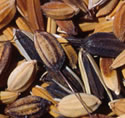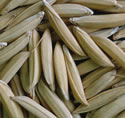Why is varietal purity in paddy rice important?
Paddy rice is at its highest milling potential when it consists of only one variety. If paddy rice contains a mixture of varieties, the different sizes and shapes of the grains make it difficult to adjust the rice mill's hullers and polishers to produce whole grains. This can result in:
- low initial de-hulling efficiencies
- a higher percentage of paddy rice needing to be re-circulated
- non-uniform whitening
- an overall lower grade of milled rice
 |
 |
| Paddy rice sample with mixed varieties. | Paddy rice sample with single variety. |
Two methods for measuring varietal purity
There are two methods for testing the varietal purity of paddy:
- Measuring grain dimensions to compare the length-width ratio of grains to the published ratio for the variety.
- Measuring the 1000-grain weight of paddy and comparing the results to the published 1000-grain weight for the variety.
The following table will guide you to two separate procedures for testing the varietal purity of paddy.
| To | then |
| view the procedure and accompanying worksheet for measuring grain dimensions, | click here. |
| view the procedure and accompanying worksheet for measuring 1000-grain weight, | click here. |
Next lesson